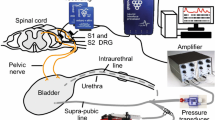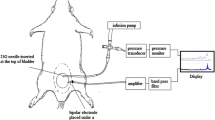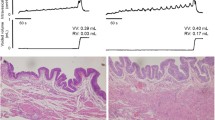Abstract
The objective of this work was to study the relation between afferent bladder nerve activity and bladder mechanics and the mechanisms that initiate and terminate bladder contractions. Bladder nerve activity, pressure and volume were recorded during the micturition cycle in the rat. The highest correlation was found between afferent nerve activity and stress (pressure×volume). Afferent nerve activity depended linearly on stress within 6%, and both slope and offset were independent of the bladder-filling rate. The levels of afferent bladder nerve activity at the onset and cessation of efferent firing to the bladder were highly reproducible with coefficients of variation of ≤17%. We propose a model in which afferent activity is proportional to bladder wall stress, and bladder contraction is initiated when afferent activity exceeds a threshold due to an increasing pressure and volume. The contraction continues until afferent activity drops below a threshold again as a result of a decreasing volume.








Similar content being viewed by others
References
Andresen M, Yang M (1989) Interaction among unitary spike trains: implications for whole nerve measurements. Am J Physiol (Regul Integ Comp Physiol 25) 256: R997
Bahns E, Ernsberger U, Jänig W, Nelke A (1986) Functional characteristics of lumbar visceral afferent fibres from the urinary bladder and the urethra in the cat. Pflugers Archiv 407: 510
Bennett BC, Kruse MN, Roppolo JR, Flood HD, Fraser M, de Groat WC (1995) Neural control of urethral outlet activity in vivo: role of nitric oxide. J Urol 153: 2004
Bíró G, Partridge LD (1971) Analysis of mulitiunit spike records. J Appl Physiol 30: 521
Buss R, Shefchyk S (1999) Excitability changes in sacral afferents innervating the urethra, perineum and hindlimb skin of the cat during micturition. J Physiol 514: 593
Chien C, Yu H, Lin T, Chen C (2000) Neural mechanisms of impaired micturition reflex in rats with acute partial outlet obstruction. Neuroscience 96: 221
Conte B, Maggi CA, Parlani M, Lopez G, Manzini S, Giachetti A (1991) Simultaneous recording of vesical and urethral pressure in Urethane-anesthetized rats: effect of neuromuscular blocking agents on the activity of the external urethral sphincter. J Pharmacol Methods 26: 161
Downie JW, Armour JA (1992) Mechanoreceptor afferent activity compared with receptor field dimensions and pressure changes in feline urinary bladder. Can J Physiol Pharmacol 70: 1457
Griffiths D (1980). Urodynamics. Adam Hilger, Bristol
Groen J, van Mastrigt R, Bosch R (1997) Computer simulation of micturition based on a detailed physiological model. Urodynamica 7: 36
Horst P, Bauer M, Veelken R, Unger T (1988) A new method for collecting urine directly from the ureter in conscious unrestrained rats. Ren Physiol Biochem 11: 325
Hosein RA, Griffiths DJ (1990) Computer simulation of the neural control of bladder and urethra. Neurourol Urodyn 9: 601
Hopp FA, Seagard JL, Kampine JP (1986) Comparison of four methods of averaging nerve activity. Am J Physiol(Regul Integ Comp Physiol 20) 251: R700
Jancsó G, Király F, Joó F, Suchs G, Nagy A (1985) Selective degeneration by capsaicin of a subpopulation of primary sensory neurons. Neurosci Lett 59:209
Jiang W, Morrison J (1996) Sensitization of pelvic nerve afferent neurones from the rat. J Auton Nerv Syst 58: 187
Kakizaki H, De Groat W (1997) Reorganization of somato-urethral reflexes following spinal cord injury in the rat. J Urol 158: 1562
Kruse M, Belton A, De Groat W (1993) Changes in bladder and external urethral sphincter function after spinal cord injury in the rat. Am J Physiol (Regul Integ Comp Physiol 33) 264: R1157
Lee J, Tillig B, Perkash I, Constantinou C (1998) Effect of alpha1 adrenoceptor antagonist on the urodynamics of the upper and lower urinary tract of the male rat. Neurourol Urodyn 17: 213
Le Feber J, van Asselt E, van Mastrigt R (1997) Neurophysiological modeling of voiding in rats: bladder pressure and postganglionic bladder nerve activity. Am J Physiol (Regul Integ Comp Physiol 41) 272: R413
MacIver M, Tanelian D (1993) Free nerve ending terminal morphology is fiber type specific for A delta and C fibers innervating rabbit corneal epithelium. J Neurophysiol 69: 1779
Maggi CA, Giuliani S, Santicioli P, Meli A (1986) Analysis of factors involved in determining urinary bladder voiding cycle in urethan-anesthetized rats. Am J Physiol (Regul Integ Comp Physiol 20) 251: R250
Maggi CA, Meli A (1986) Do “conscious “ and “reflex” micturition have separate sensory input ? Implications for clinical urodynamics. Neurourol Urodyn 5: 563
Maggi C, Conte B, Furio M, Santicioli P, Giuliani S, Meli A (1989) Further studies on mechanisms regulating the voiding cycle of the rat urinary bladder. Gen Pharmac 20: 833
Maggi CA, Conte B (1990) Effect of urethane anesthesia on the micturition reflex in capsaicin-treated rats. J Auton Nerv Syst 30: 247
Mallory B, Steers WD, De Groat WC (1989) Electrophysiological study of micturition reflexes in rats. Am J Physiol (Regul Integ Comp Physiol 26) 257: R410
Mersdorf A, Schmidt R, Tanagho E (1993) Urodynamic evaluation and electrical and pharmacologic neurostimulation. The rat model. Urol Res 21: 199
Morrison JFB, Sato A, Sato Y, Yamanishi T (1995) The influence of afferent inputs from skin and viscera on the activity of the bladder and the skeletal muscle surrounding the urethra in the rat. Neurosci Res 23: 195
Morrison JFB, Kibble A, Jiang W (1998) Sensory mechanisms in the urinary tract. J Physiol 507.P: 2S
Morrison J (1999) The activation of bladder wall afferents. Exp Physiol 84: 131
Moss N, Harrington W, Tucker M (1997) Pressure, volume, and chemosensitivity in afferent innervation of urinary bladder in rats. Am J Physiol (Regul Integ Comp Physiol 41) 272: R695
Namasivayam S, Eardley I, Morrison J (1998) A novel in vitro bladder pelvic nerve afferent model in the rat. Br J Urol 82: 902
Satchell P, Vaughan C (1994) Bladder wall tension and mechanoreceptor discharge. Pflugers Arch 426: 304
Schmidt EM (1984) Instruments for sorting neuroelectric data: a review. J Neurosci Methods 12: 1
Sengupta J, Gebhart G (1994) Mechanosensitive properties of pelvic nerve afferent fibers innervating the urinary bladder of the rat. J Neurophysiol 72: 2420
Shafik A, Shafik AA, El-Sibai O, Ahmed I (2003) Role of positive urethrovesical feedback in vesical evacuation. The concept of a second micturition reflex: the urethrovesical reflex. World J Urol 21: 167
Shefchyk S (2001) Sacral spinal interneurones and the control of urinary bladder and urethral sphincter muscle function. J Physiol 533: 57
Steers W, de Groat W (1988) Effect of bladder outlet obstruction on micturition reflex pathways in the rat. J Urol 140: 864
Thor K, Muhlhauser MA (1999) Vesicoanal, urethroanal, and urethrovesical reflexes initiated by lower urinary tract irritation in the rat. Am J Physiol (Regul Integ Comp Physiol 46) 277: R1002
Van Asselt E, le Feber J, van Mastrigt R (1999) Threshold for efferent bladder nerve firing in the rat. Am J Physiol 276 (Regul Integ Comp Physiol 45): R1819
Van Duin F, Rosier PFWM, Rijkhoff NJM, van Kerrebroeck PEV, Debruyne FMJ, Wijkstra H (1998) A computer model of the neural control of the lower urinary tract. Neurourol Urodyn 17: 175
Van Mastrigt R (1977) A system approach to the passive properties of the urinary bladder in the collection phase. PhD thesis, Erasmus University, Rotterdam
Van Mastrigt R, Coolsaet B, van Duyl W (1978) Passive properties of the urinary bladder in the collection phase. Med Biol Eng Comput 16: 471
Wiemer W, Kaack D, Kezdi P (1975) Comparative evaluation of methods for quantification of neural activity. Med Biol Eng 13: 358
Winter DL (1971) Receptor characteristics and conduction velocities in bladder afferents. J Psychiat Res 8: 225
Yaksh TL, Durant PA, Brent CR (1986) Micturition in rats: a chronic model for study of bladder function and effect of anesthetics. Am J Physiol (Regul Integ Comp Physiol 20) 251: R1177
Yoshimura N, Erdman S, Snider M, De Groat W (1998) Effects of spinal cord injury on neurofilament immunoreactivity and capsaicin sensitivity in rat dorsal root ganglion neurons innervating the urinary bladder. Neuroscience 83: 633
Acknowledgements
This study was supported by the Dutch Kidney Foundation (grant C95.1429). J. le Feber currently works at the Department of Mathematics and Computing Sciences of the University of Groningen and is grateful to this institution for the permission given to revise this manuscript.
Author information
Authors and Affiliations
Corresponding author
Appendix
Appendix
Calculation of bladder wall tension (T) and stress (σ).
The bladder is approximated to a sphere with radius R (Fig. 9):
Calculation of bladder wall tension and stress. The bladder is approximated to a sphere with radius R. The force that drives the two semi-spheres apart is balanced by the force keeping them together: Ftension. Tension is calculated as Ftension/(circumference of cross section) and stress as Ftension/(area of cross section)
Tension
The ring area, Aring, can be calculated as
The force on this ring, Fring equals P·Aring. P is bladder pressure.
The vertical component, Fring,up, equals Fring·sinα. Thus:
Integration yields the force that drives the two semispheres apart, Fup:
The force that keeps both semispheres together, Ftension, equals Fup. Wall tension is defined as Ftension divided by the circumference of the cross section:
Stress
Stress (σ) is defined as Ftension divided by the area of the cross section. If d is the wall thickness, this area equals π(R+d)2−πR2=2πRd+πd2. Assuming that d<<R yields:
However, when the bladder is almost empty this approximation is not valid.
With a non-negligible wall thickness, the tangential stress in the wall at radius r can be calculated [41]:
With Pin=pressure inside sphere; Pout=pressure outside sphere; rin=inner radius; rout=R=outer radius.
With V=bladder volume and Vt=tissue volume:
with (A.7), (A.8) and (A.9):
Mean stress in bladder wall:
from (A.12) and (A.13):
Where P=Pin−Pout, and Pout is considered a constant. The term 1/4P becomes negligible if (3PV/2Vt)/0.25P>10, i.e. if 6 V/Vt>10.
In rats Vt averages 0.2 cm3. Thus, the pressure term is negligible if V>0.33 cm3 and should be accounted for only at low bladder volumes.
If nerve activity is proportional to stress then:
Or under the above assumption:
Rights and permissions
About this article
Cite this article
le Feber, J., van Asselt, E. & van Mastrigt, R. Afferent bladder nerve activity in the rat: a mechanism for starting and stopping voiding contractions. Urol Res 32, 395–405 (2004). https://doi.org/10.1007/s00240-004-0416-8
Received:
Published:
Issue Date:
DOI: https://doi.org/10.1007/s00240-004-0416-8





